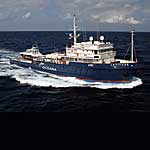Conservation
Research Ship Heads to Gulf for Oil Damage Assessment

More than a hundred days after the Deepwater Horizon oil rig exploded, it appears that BP has finally succeeded in controlling the blowout that spewed millions of gallons of oil a day into the Gulf of Mexico. Yet to paraphrase Winston Churchill, this is just the end of the beginning. The creatures that live in, and the people that depend on the Gulf of Mexico will be affected by the oil spill for years, and we are just starting to comprehend the scope of this tragedy.
Coral Reef Program in Key Largo

Divers can work side-by-side with marine scientists to aid in reef restoration during a series of coral restoration dives set for October 19-22 at Amoray Dive Resort in Key Largo. Focused on environmental education, the group advocacy trips are to include educational lectures and dive programs to restore endangered staghorn and elkhorn corals. Hands-on activities are planned for both on land and offshore at Key Largo’s Coral Restoration Foundation nursery and surrounding reefs.
Oil, Oil, Everywhere! (Well, Actually, No...)
![]()
August 11, 2010: Seas covered with a thick, oily sludge. Wrecks and reefs decimated by an onslaught of black goo. Divers lost in a sea of black, inky water. It’s a nightmare image — except that it never happened. As is so often the case, the greatest damage to Florida’s dive industry came not from the outpouring of oil from the Deepwater Horizon site, but rather from a misunderstanding of how this tragedy has affected the Sunshine State.
Wii Technology Exposes Shark Mating Behavior
![]()
Motion sensors like those used in smart phones are helping to reveal how sharks spend each moment in the wild, say Mote Marine Laboratory scientists who were the first to use such sensors to classify mating and other behaviors in wild sharks. During their study, Mote scientists monitored mating in wild nurse sharks by attaching accelerometers to them. Accelerometers are the motion-sensitive computer chips used in smart phones, iPods and the Nintendo Wii. Attached to sharks, accelerometers can detect each flick of a shark’s tail or tilt of its body and give scientists insight into what sharks are doing and when.
Positive Encounters With Gentle Giants
![]()
This is the time of year when Florida’s manatees cluster in Crystal River and Homosassa to avoid the colder waters of the Atlantic and Gulf. It is also the time when divers flock to the same locations to interact with these gentle giants. Among the best ways to enjoy a manatee encounter is to take advantage of one of the many commercially operated manatee tours. This not only increases your chances of seeing manatees, it also helps reduce the risk that you will accidentally cause harm to these big fellows, or run afoul of the many laws protecting them.
NOAA Seeks Public Comment
![]()
NOAA seeks comment on a proposed rule prohibiting the discharge of sewage from vessels into Florida Keys National Marine Sanctuary waters and to require vessel sewage tanks be locked to prevent discharges within sanctuary boundaries. Vessel sewage discharge has been prohibited in state waters of the sanctuary since their designation as a No Discharge Zone by the US Environmental Protection Agency in 2002. Although 65 percent of the sanctuary is within state waters, the remaining federal waters, with the exception of specially-protected zones, currently permit vessel sewage discharge.
The Bridge
![]()
Local divers simply call it The Bridge. It is the span at Blue Heron Boulevard that crosses the Intracoastal Waterway from the mainland in Riviera Beach, Florida, just east of Dixie Highway (US-1), to Singer Island. The bridge is south of the Lake Park town line. It is a high fixed bridge to allow navigation without opening. At the east end, before reaching Singer Island, is Phil Foster County Park. There is plenty of free parking and a no-charge boat launching ramp in the park on the north side of Blue Heron Bridge. There are restrooms, showers, toilets and picnic tables.
Bad to the Last Drop
LIt looks like the smokestack of a gigantic ocean liner lying on its side. The Delray Beach, Florida sewage outfall pipe sticks up from the floor of the Atlantic Ocean about a mile offshore of the city’s public bathing beaches. The large steel pipe arches up, pointing toward the surface 90 feet above. A brown plume of effluent floated upward and was carried away with the current. This sewer pipe, and others like it in Florida and other coastal states, is the direct cause of death of coral reefs and marine life.
Bahamas Bans Turtle Fishing
Soups, stews and pies flavored with chunks of sea turtle meat is now illegal across the 700 islands of the Bahamas. Despite opposition from many fishermen, the Bahamas has amended fisheries laws to give full protection to all sea turtles found in the Atlantic archipelago’s waters by banning the harvest, possession, purchase and sale of the endangered reptiles, including their eggs.
Manatees Face Off With Humans on Busy Waterways
“They flipped us off and cursed at us.” The woman was distraught. An injured West Indian Manatee, one of perhaps 3,100 left in the State of Florida, was in distress near the Boynton Beach Municipal Boat Ramp. The woman and her friends had spotted the injured manatee, along with four others including at least two pups that remained with the injured mother. The woman had been waiting almost two hours since calling every organization they could to get help for the manatee.
